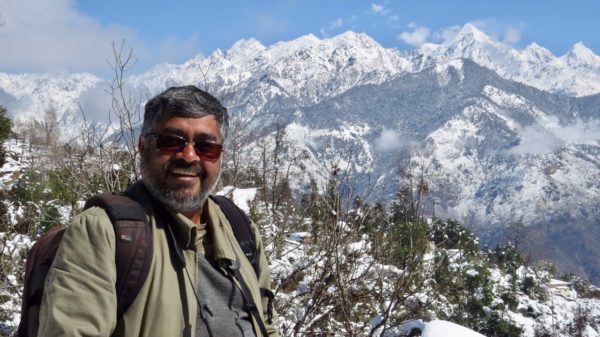Meet Sanjay Sondhi, a conservationist working to spread awareness among communities and children.

Human-leopard conflicts in the past few years have been all over the news in recent times. “Leopard Runs Loose, Terrorizing Residents”, “Leopard injures four after rampage in village in India”, “Leopard deaths at a five-year high in the country” and so on. Conservationists who are trying to mitigate such encounters have a different tale to say.
Sanjay Sondhi, a Dehradun-based naturalist who works closely on leopard conflicts, believes there has not been a rise in attacks, rather an increased media hype. There have been years of rise and drop in these incidents and the reason is not too well known.
His work includes conservation education and outreach, biodiversity assessments, incentivizing conservation through community-led ecotourism and mitigating human-wildlife conflict, mainly in the eastern and western Himalayas.
Sanjay speaks about how the presence of leopards in human dominated landscapes invariably leads to strain on local communities. He says conflicts can be complex socio-economic issues, largely because of “palaayen” (people migrating from the hills to the plains) and fields being abandoned. These abandoned fields are taken over by Lantana and Eupatorium, which provides a place for leopards to seek refuge. Sanjay also mentions a decline in the trend of owning livestock, and how families now own fewer animals than in the past. The pinch is felt even more now when people owning just two cattle heads lose one, unlike in the past when they had over 20.
Wildlife conflicts can be complex, he says, as it involves economic issues, forests, livelihoods and the leopards. His work with Vidya Athreya over a 10-year period helped show that conflict intensity had not increased in most places. Although sporadic, the conflicts seem to be highlighted due to easier communication, sensationalization by media and because it could very easily become a political issue. “The conflict has not significantly increased in Uttarakhand, there’s just more noise in the system,” explains Sanjay.
A founder trustee of Titli Trust, Sanjay set up the trust in 2009 as a small NGO. The trust focuses on three broad areas: Bio-diversity research and conservation; Conservation and livelihoods; and Human-wildlife conflict. The program helps support local communities to do nature-linked tourism in Garo Hills, Meghalaya, Nagaland, Pakke Tiger Reserve, Eaglenest Wildlife Sanctuary in Arunachal; Devalsari, Pawalgarh Conservation Reserve in Uttarakhand to name a few. Sanjay aspires to establish communities which are committed both to conservation as well as livelihoods in tune with nature.
Awareness materials and workshops hosted by Titli Trust in Uttarakhand have had a positive impact on not just the local communities but also the forest department. A booklet called “Busting Myths About Leopards”, drafted in both English and Hindi highlights leopard behavior, the status of leopards in Uttarakhand and dispels myths people have about leopards by backing it with scientific knowledge. With this, the forest department now has a document that lists the measures that can be taken when conflicts arise. Media workshops have been held in Pauri and Tehri too. Local communities are also engaged by a children’s ambassador program, results of which are too early to estimate, says Sanjay.
He speaks about the importance of co-existence of people and wildlife, however difficult it may seem, noting, “Our generation has probably lost the plot, focused as we see on earning money and being out of sync with nature. We are sowing seeds with children and local communities which hopefully will sprout and give rise to movements where growth is in sync with nature.”
Sanjay’s vast respect for the natural world comes from a very young age when he spent time with his grandparents in Himachal. With an engineering degree and the enthusiasm to make a difference, he has devoted his life to conservation. He has spent his early years in a corporate job and with support from his wife who is an environmentalist, he switched to purse his present calling.